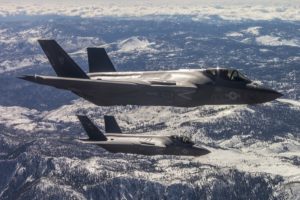Last week Navy officials told a House panel how the service plans to close the current strike fighter shortfall years earlier than previously planned via a set of fleet structure and maintenance plan changes.
Rep. Vicky Hartzler (R-Mo.), ranking member of the House Armed Services tactical air and land forces subcommittee, asked Navy officials during a hearing July 13 how the Navy is asserting it will resolve the shortfall by fiscal year 2025 when last year officials told the committee it did not plan to achieve the inventory goal until 2030.
Last year, the then-Navy top acquisition official James Geurts said the service projected a 49-fighter gap in fiscal year (FY) 2021 and a 12-fighter gap by FY ‘24. Geurts now currently serves as performing the duties of the Under Secretary of the Navy.
Acting Navy acquisition chief Jay Stefany said that “a number of things have changed in the last year as far as the ability of us to meet that shortfall.”
Rear Adm. Andrew Loiselle, Director of the Air Warfare Division (OPNAV/N98), said the Navy made “several changes to the math” such that the number of F-35C squadrons per carrier air wing reduced from two to one while increasing the planes per squadron from 10 to 14.

The service also will replace F/A-18E/F reserve fighters used as “red team” opposition forces with F-16s acquired from the Air Force and Air National Guard and F-5s bought from Switzerland.
Loiselle also noted Navy professional maintainers were able to return 28 Super Hornets from “long-term down status and put those back into the fleet.”
“So we believe that the combination of those improvements has reduced our strike fighter shortfall to 0 by 2025, based on current year analysis.”
Loiselle underscored that this analysis is repeated annually and the current figures are based on current budget projections.
Loiselle also addressed the Navy’s Service Life Modification (SLM) program in which aircraft producer Boeing [BA] takes Block II aircraft nearing the end of their 6,00 hour service lives and upgrades them to the new Block III configuration of the newest Super Hornet model.
Block III aircraft are designed to feature improvements like conformal fuel tanks to add 100-120 nautical miles in range, a 10,000 flight hour lifespan, reduced radar signature, enhanced network capabilities, and upgrades to the Block II Infrared Search and Track System sensor and Active Electronically Scanned Array (AESA) radar.
Boeing delivered the first Block II Super Hornet updated with SLM last year. The SLM work is being split by starting extending the life of the aircraft from 6,000 to 7,5000 flight hours and in a second segment further extend the flight life to 10,000 hours as well as add other Block III improvements (Defense Daily, Feb. 6, 2020).
At the time, Boeing said it was taking 18 months to work on this first segment of modifications per aircraft, but it expected that to improve to 12 months as the program progresses. In 2019 Boeing said it plans to modify up to 40 Block II Super Hornets per year at the program’s peak (Defense Daily, May 7, 2019).
Loiselle said Boeing has two SLM lines operating and the Navy expects there to be additional capacity available by 2025 to take additional SLM aircraft “should our current analysis be revised and we require that additional capacity. We believe the infrastructure will support additional modifications to the Block III sets.”
Hartzler asked that given more Super Hornets are being found with more salt corrosion than originally planned for, how can the Navy expect to be able to handle pushing more aircraft through the SLM and maintenance process in time to meet fleet requirements.
Loiselle agreed there was “damage beyond expectation from a corrosion perspective on some of the initial aircraft,” but also said Boeing is seeing “significantly improved condition in the aircraft that we are now submitting for SLM.”
“So with the number of Block II Super Hornets in our current inventory, compared to the number of Block II Super Hornets that we intend to conduct SLM on, that allows us some selectivity in those tails that we put through the modification line,” Loiselle continued.
He added the Navy is learning from the process and is conducting inspections before an aircraft is inducted into SLM to identify if corrosion is present and justifies delaying induction. Loiselle said the Navy can mitigate corrosion damage cheaper by using its own artisans and engineers to repair such corrosion damage before an airframe is sent to Boeing for SLM work because there are enough other aircraft to undergo the SLM process.
“Right now we are continuing to learn and we are continuing to bring down the time associated with getting an aircraft through the SLM process.”
Loiselle said the Navy expects that by 2025 the two Boeing SLM lines will be at full capacity and by 2023 the SLM process should take one year per aircraft.